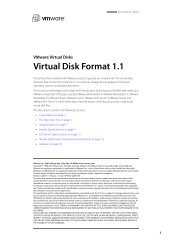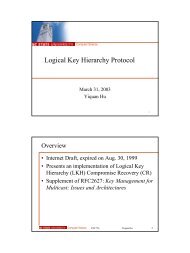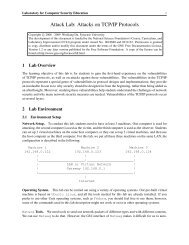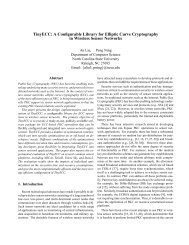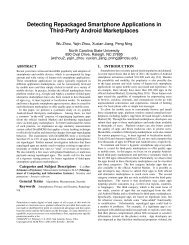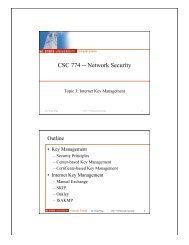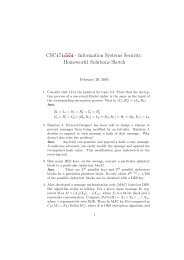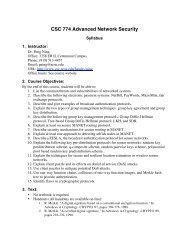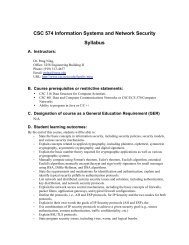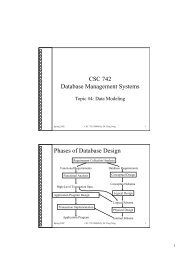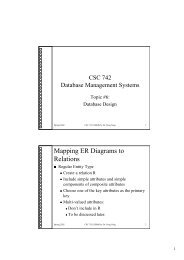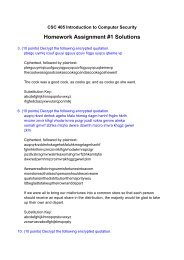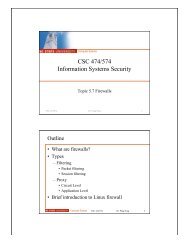Correlating Alerts Using Prerequisites of Intrusions - Dr. Peng Ning ...
Correlating Alerts Using Prerequisites of Intrusions - Dr. Peng Ning ...
Correlating Alerts Using Prerequisites of Intrusions - Dr. Peng Ning ...
You also want an ePaper? Increase the reach of your titles
YUMPU automatically turns print PDFs into web optimized ePapers that Google loves.
5 Discussion<br />
5.1 Systematic Development <strong>of</strong> Predicates and Hyper-alert Types<br />
Since predicates are used to represent the prerequisites and consequences <strong>of</strong> hyper-alerts, they form the<br />
foundation <strong>of</strong> our approach. In order to make the proposed approach feasible, we need to make sure that<br />
we can develop the predicates required for hyper-alert correlation in a cost-effective way. In addition, we<br />
should avoid possible inconsistency among the predicates, and have certain ways to ensure the developed<br />
predicates can support the proposed approach.<br />
It is worth noticing that the predicates can be represented in different granularities. For example, the<br />
situation that a host runs an sadmind service vulnerable to buffer overflow attack can be represented either<br />
by UDPVulnerableToBOF (VictimIP, VictimPort), which simply says that a service at IP address VictimIP<br />
and port number VictimPort is vulnerable to buffer overflow attacks, or by SadmindVulnerableToBOF (VictimIP,<br />
VictimPort), which specifically says that the sadmind service at IP address VictimIP and port number<br />
VictimPort is vulnerable to buffer overflow attacks, or even more specifically by SadmindVulnerableTo-<br />
BOFType123 (VictimIP, VictimPort), which in addition specifies which type <strong>of</strong> buffer overflow attacks the<br />
sadmind service is vulnerable to.<br />
The granularities in which the predicates are developed have impact on alert correlation. On the one<br />
hand, the finer grained the predicates are, the more precise we can expect the result to be. On the other hand,<br />
the cost for developing finer-grained predicates would be higher than coarser-grained ones. Moreover, the<br />
finer-grained the predicates are, the less they can accommodate variations <strong>of</strong> attack strategies.<br />
Each hyper-alert type corresponds to a class <strong>of</strong> hyper-alerts that share the same prerequisites and consequences.<br />
The development <strong>of</strong> hyper-alert types depends on what kinds <strong>of</strong> predicates are used. Although we<br />
developed the hyper-alert types and the involved predicates in an ad-hoc way, it is possible to develop them<br />
systematically.<br />
Lindqvist and Jonsson presented a classification <strong>of</strong> intrusions in [11]. In particular, they provided a hierarchical<br />
classification <strong>of</strong> intrusion results. The top-level classes <strong>of</strong> intrusion results include three classes:<br />
exposure, denial <strong>of</strong> service (DOS), and erroneous output. We plan to use this classification (with a little<br />
modification) as the framework to systematically develop predicates as well as hyper-alert types. Specifically,<br />
we classify all possible consequences into groups and divide each group into more specific groups<br />
using their classification scheme. We can start to specify predicates when the arguments <strong>of</strong> a group can be<br />
fixed.<br />
Figures 4(a) to 4(c) show our classification scheme. The leaf-level groups may be further partitioned when<br />
necessary. In the original classification, the top-level class exposure is classified into two classes: disclosure<br />
<strong>of</strong> confidential information and service to unauthorized entities. However, we observe that some attacks<br />
may reveal information that is not confidential but useful for latter attacks. For example, an IPSweep may<br />
discover hosts accessible from the network, though the existence <strong>of</strong> the hosts are not exactly confidential but<br />
available to the public. Thus, we added a third class named discovery <strong>of</strong> public information.<br />
In addition, Common Vulnerabilities & Exposures (CVE) [3] may be used to assist predicates and hyperalert<br />
types development. The current version (version 20010918) <strong>of</strong> CVE database has 1,604 entries. By<br />
applying the above classification scheme, we can group these entries into different classes and then develop<br />
the predicates and hyper-alert types within each final group. For example, we may have the predicates<br />
ExistHost (IP) and ExistService (IP, port) in the subgroups <strong>of</strong> exposure.public info.<br />
It is necessary to keep the implication relationships between predicates in order to reason about the<br />
prepare-for relations between hyper-alerts. In our implementation [14], human users are required to input<br />
14



